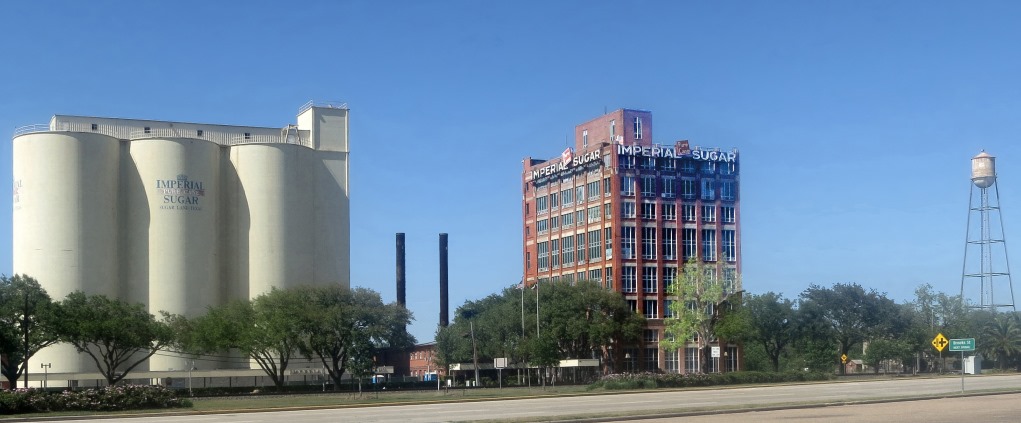The city of Sugar Land, Texas got its name from the huge Imperial Sugar Company operations. The company was founded in 1908, and went out of business in 2004.
The buildings of the Imperial complex have been sitting abandoned since then.
On December 1, 2022, PUMA Development announced that—in partnership with the city—they will preserve and redevelop the historic Imperial Char House, the city of Sugar Land’s most iconic building.
PUMA’s vision for the remainder of the Imperial Historic District, similar to the city’s Land Use Plan, is to develop a walkable, mixed-use project comprising experiential retail, dynamic entertainment, unique food and beverage, top-notch fitness, multi-family and single-family residential, commercial office space, outdoor parks and more.
PUMA, a Houston-based boutique development firm specializing in creating experience-driven, mixed-use communities, has requested support from the city of Sugar Land and the Sugar Land Development Corporation (SLDC) toward preservation of the Char House and eventual development of the remainder of the Imperial Historic District.
Sugar Land City Council and SLDC will be considering financial support of the project as it progresses.
“The city partnering with PUMA Development is a unique opportunity for our city to continue its legacy of world-class public private partnerships,” said Sugar Land Mayor Joe Zimmerman.
“The Imperial Char House involves the special history of Sugar Land, and I’m very excited to get behind this project and promote the continued growth and success of our city,” he added.
Years of public input have shown the need for denser redevelopment with a diversity of housing options that will provide a stronger tax base to maintain Sugar Land’s high level of services and amenities while maintaining one of the state’s lowest tax rates.
This type of development also has many other benefits, such as creating desirable workplaces for new, expanded and existing businesses, pathways to homeownership, public infrastructure improvements and quality of place amenities.
“The historic district is one of the top priorities of our City Council and extremely important to our residents and our history,” said City Manager Michael W. Goodrum.
“Projects like this are expensive and complex and will need financial support from the city and other available financial tools to be feasible. To ensure a desirable development that strengthens our economy, protects our neighborhoods and responds to the expectations of our community to preserve where we began, the city must consider investing in our future,” he continued.
The Hunton Group, the current property owner of all of the historic buildings of Imperial, has been working diligently to find the right developer for the property.
“We have been working for over a year to find the right partner for the Imperial project that will do justice to the history of Imperial and the City of Sugar Land and develop the site to its full potential,” said R.O. Hunton, founder of the Hunton Group.
“Imperial exemplifies entrepreneurialism and innovation,” said Mark Toon, managing partner of Work America Capital and founder and chief executive officer of PUMA.
“Imperial created thousands of jobs, and it is hard to find a better example of how a company can create an economic boom for a town or region,” he concluded.
Opportunities for public input will be available at two town halls co-hosted by PUMA and the City on Dec. 8 and Dec. 15 at 5:30 p.m. at the Sugar Land Heritage Museum and Visitor Center, 198 Kempner Street. Additional opportunities for public input will be available via community meetings, email updates and public hearings as the project progresses. Updates will also be posted at www.sugarlandtx.gov/ImperialHistoricDistrict.
Before the vast area now known as Texas was stolen from Mexico, Stephen F. Austin‘s colonists brought sugar cane to what later became Fort Bend County in the 1820s. The Sugar Land area was once part of Oakland Plantation, where Nathaniel and Matthew Williams planted sugar cane about 1840.
They began processing the cane in 1843 using a horse-powered mill and open-air cooking kettles. In 1853 the plantation and mill were purchased by William J. Kyle and Benjamin F. Terry. They improved the mill and promoted a railroad for the area, which they named Sugar Land. Terry later helped organize the famed Confederate cavalry unit, Terry’s Texas Rangers, and was killed in the Civil War.
After the war, the operation was sold to Edward H. Cunningham, who expanded the sugar mill into a refinery. W. T. Eldridge and Galveston businessman I. H. Kempner, Sr. bought the refinery in 1907. They began importing raw sugar to operate the refinery year-round because local cane was available only seasonally and in decreasing quantities in the early 1900s.
Named by Kempner for the Imperial Hotel in New York City, the Imperial Sugar Company and the City of Sugar Land grew steadily. During the 1970s, the Imperial Sugar Company produced more than three million pounds of refined cane sugar daily.
Thanks to reader Julia Oxarango-Ingram for bringing this news to our attention!
2014 photo courtesy of Jim Evans via Wikipedia.

